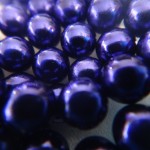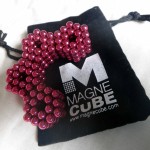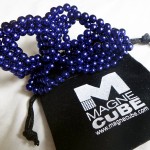MagneCube Magnetic Puzzle
By now you’ve probably heard of BuckyBalls, and perhaps even Zen Magnets and NeoCube. They’re all the same thing; sets of small 5mm magnetic balls which attract together in a variety of combinations. Most of these are either sold primarily in the US, or at quite expensive prices which would turn the ordinary buyer ( someone who hasn’t played with these things before and become addicted to them ) off buying them. MagneCube have identified this gap in the market and brought the neodymium magnetic balls to the UK, at £14.99 a set or £15.99 for the coloured versions. Not bad, considering imported BuckyBalls will cost you something in the region of £25.
Now, whilst there are other sizes of MagneCube, and even cube-shaped magnets which play very differently; I’ll leave these to another article. Here I’m going to be talking about MagneCube 5mm balls, comparing them to the likes of BuckyBalls and a cheap no-brand alternative, and cooing over the pretty colours they sent me to try out.
Now, I must state that I became addicted to these neodymium magnet toys before finding the guys at MagneCube, a college at work had picked up a cheap set from Amazon to give them a go and he must receive the credit for discovering these addictive little things. I played with his set compulsively and found it difficult to put them down, they may be the desk toy to end all desk toys when it comes to pure addictiveness. Suffice to say, I had to obtain my own set and, as luck would have it, I found some on sale in a local random-gadgety-tat store. The set I picked up were genuine BuckyBalls, sexily packaged and, by far, the most polished and professional of the neodymium magnet balls when it comes to presentation. Don’t be fooled, however, when it comes down to the nitty gritty they’re no better than MagneCube’s balls.
My addiction to BuckyBalls was such that I decided to seek out a benefactor so I could bring coverage of them to Gadgetoid, complete with sexy photos, and a hands-on of the different sizes, colours and types that I would never convince the wife to let me buy. MagneCube sent me some large nickel 7mm balls, some 5mm balls in two colours; pink and purple, some regular 5mm nickel balls, a set of small 2mm balls and, finally, the MagneCube “Block” which consists of actual cubes.
From this I could get a feel for their entire range and, of course, do the inevitable comparison with both BuckyBalls and the generic Amazon balls which my colleague picked up.
The Comparison
I don’t blame you if you skipped down to here. Most of the 5mm magnetic balls come in sets of either 216 or 125, but for the purposes of this comparison I’m only looking at the 216 set. 216 balls are great for a number of configurations and I’d highly recommend them over just 125 for both value and playability.
Let’s get down to business. First and foremost:
Let’s start with the packaging
Dull, I know, but packaging is pretty important when it comes to little magnetic balls.
BuckyBalls come in a plastic box designed to show them off. It’s a nuisance to get open and, naturally, an environmental disaster waiting to happen, but you can’t blame them for wanting to differentiate their product with good looks. In the bottom of the BuckyBalls package comes a small plastic box which you can use to store the balls, and part of the packaging seems to double up well as a “cutter” for separating the balls.
MagneCube came in unassuming but recyclable cardboard boxes. It’s worth noting that this is not the final retail packaging and I’ll be amending this review to take account of that later. Inside the box comes a little draw-string bag and an excellent tin which has a perfect-fit foam cut-out inside to hold your magnetic balls as safely and securely as you’re likely to get. Also included is a nice little plastic credit-card shaped separator. For bonus points, MagneCube comes with 4 extra spare balls magnetically ( of course ) attached to the bottom of each and every tin. This is pretty awesome, as BuckyBalls charge a few dollars for 10 spare balls, and without spares you’ll have a hard time making a 1-ball-short set back into a cube.
Generic, there’s not much to say about these. The set came in a small jiffy back and included nothing else. No tin, no cutter, no spares, just a poorly packaged, squashed cube.
The winner? Easily MagneCube. BuckyBalls packaging is sexy, but that doesn’t do much once you toss it in the bin. The MagneCube tin is much more durable than their plastic tub, and the balls don’t rattle around inside it. The free spares are an excellent addition that really shows the thoughtfulness of the guys behind MagneCube.
So, what about the quality
BuckyBalls have a good finish and a noticeably stronger magnetism than the generic balls. One of my BuckyBalls has a slight dent in it, which can be a nuisance but the set is otherwise great and has proved to be durable thus far.
MagneCube, like BuckyBalls, are well finished, even the coloured versions which are striking, strong colours and seem durable enough. They’re as magnetic, if not ever so slightly more, as the BuckyBalls and no amount of play has caused any visible wear and tear on them yet.
Generic came with one slightly rusty looking ball and there’s a definite bit of flaking there. They were supposed to be black, but came in a slightly darker Nickel than the normal colour. They’re very noticably less magnetic than both BuckyBalls and MagneCubes which makes them easier to separate and play with, but harder to make any lasting coherent structure or pattern with.
The winner? A tie between BuckyBalls and MagneCube. I only tried one BuckyBalls set, so I can’t tell if the dent is a common occurrence or just bad luck on my part. All I can say about the Generic ones is: avoid, avoid, avoid!
And playability
BuckyBalls and MagneCube both play the same. They’re strong magnets and no mistake, making them difficult to separate by hand and meaning that the separator included in each set is extremely useful.
The Generic set is much easier to manually separate, but the lower magnetism means that it’s hard to build a structure, like the hexagonal pillar, and keep it in shape as you play with it and reconfigure the balls. It’s worth noting that, despite the lower magnetism, the balls still all connect together in a long row and the bonds certainly support the weight of all 215 other magnets.
All of these magnetic balls love to connect in one straight line, and that’s when their bond is strongest. You can reconfigure them into hexagons, triangles and squares once you know how, and these shapes constitute the basic building blocks of anything more complicated.
Overall
Whilst there’s nothing wrong with BuckyBalls, they’re expensive in the UK and really have nothing to offer over Magnecube. Magnecube may be cheaper, but their metal tin, draw-string bag and free spares bring them head and shoulders above the rest in terms of value. Ultimately, if you’re interested in playing with little magnetic balls, buy from Magnecube and you wont be disappointed. If you’re not interested, you should be… every desk should have a set of these!


